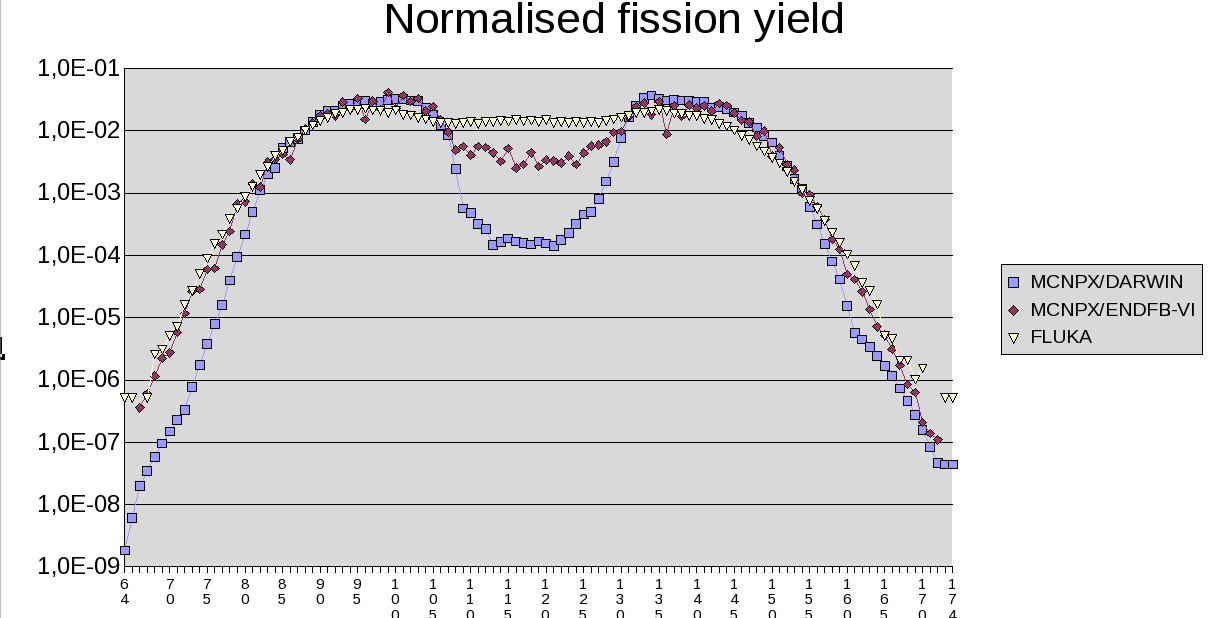- Previous message: Ercan Pilicer: "LET spectrum in a spacecraft Si component"
- In reply to: Ercan Pilicer: "LET spectrum in a spacecraft Si component"
- Next in thread: Feracci Vincent: "Re: Trouble with fission yield"
- Maybe reply: Feracci Vincent: "Re: Trouble with fission yield"
- Messages sorted by: [ date ] [ thread ] [ subject ] [ author ] [ attachment ]
Hi,
I am currently simulating a U238 target bombarded by high energy neutrons
(~1 MeV->40 MeV, mean energy ~ 12 MeV) and I am interested in the
fission yield of U238. I compare the results with MCNPX coupled with
DARWIN. However, the results I obtain aren't exactly what I expected :
- In terms of fission rate, I have almost the same results with MCNPX
and FLUKA
(~ 6.E+13 fission/s)
- In terms of fission yield there are two differences, one in amount :
Using MCNPX with DARWIN, I find that 1,1E+14 fission fragments (I
considered elements with 25<Z<67) are generated per seconds which
seems to agree with a 6.E+13 fission/s fission rate.
On the other hand, using the RESNUCLEI card in FLUKA, I find that only
3,4E+13 fission fragments are generated per second. This value seems
to be 3 or 4 times too low. Is it just that there is obviously
something wrong with my input? (I have put my input in attachment plus
the source routine I use)
However RESNUCLEI tells me that a great quantity of U238 is produced
in inelastic interactions( ~ 1.4E14 nuclide/s). Does this mean that
some of these interactions are fissions but RESNUCLEI only gives info
on an intermediate state?
( supposing the U238 nuclide didn't break immediately but is excited
and will break shortly but the fission products won't be accounted for
in RESNUCLEI).
My other concern is the shape of my fission fragment spectrum :
I have compared the normalized fission fragment spectrum obtained by
using FLUKA with the results obtained using MCNPX with DARWIN and by
using ENDFBVI fission yield values with the neutron fluence in the
target calculated by MCNPX.
The fission fragment spectrum obtained using MCNPX and DARWIN seems to
underestimate the formation of mid-sized fragments (110<A<125)
probably because it doesn't use tables of high energy neutron fission
yields (See attached graph).
The use of ENDFB-VI tables with values for 14 MeV neutron fissions
still gives me a difference of a factor 3 to 4 in the fission yield
for mid-sized fragments in between the FLUKA results and the ones
obtained using the ENDFB-VI tables.
In the manual it is said that fission fragments are determined using
evaluated data extracted from European, American and Japanese
databases. Could this difference come from the use of different
databases?
Or does Fluka use physic models after 14 MeV to determine fission
fragments yield?
This could explain the difference in the spectra as around 16 percent
of the neutrons which reach the target have an energy included in
between 20 and 40 MeV.
So to sum up a bit my questions, If I have around 6.E+13 fissions per
second and only 3,4E+13 fission fragments produced per second
according to RESNUCLEI, is there definitely something wrong with my
input or is there a reasonable explanation?
What tables does FLUKA use to determine the fission yield spectrum?
Does FLUKA use physic models for high energy neutrons?
Regards,
Vincent Feracci

- application/octet-stream attachment: fission_yield_calculation.inp
- text/x-fortran attachment: source_neutron.f